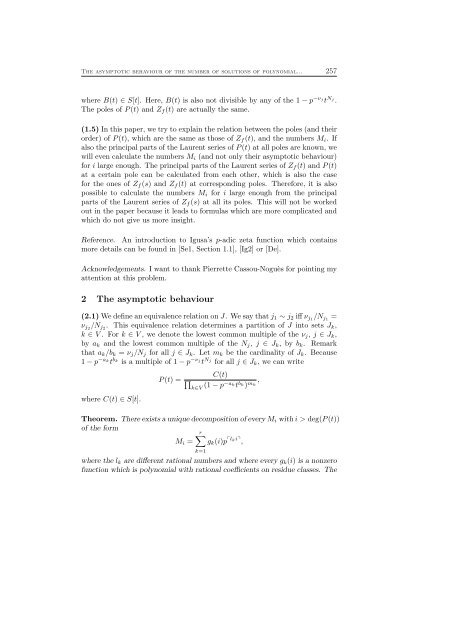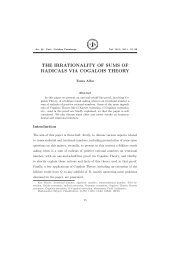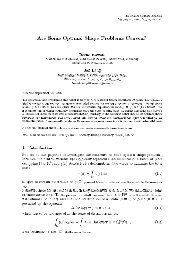The asymptotic behaviour of the number of solutions of polynomial ...
The asymptotic behaviour of the number of solutions of polynomial ...
The asymptotic behaviour of the number of solutions of polynomial ...
You also want an ePaper? Increase the reach of your titles
YUMPU automatically turns print PDFs into web optimized ePapers that Google loves.
<strong>The</strong> <strong>asymptotic</strong> <strong>behaviour</strong> <strong>of</strong> <strong>the</strong> <strong>number</strong> <strong>of</strong> <strong>solutions</strong> <strong>of</strong> <strong>polynomial</strong>... 257where B(t) ∈ S[t]. Here, B(t) is also not divisible by any <strong>of</strong> <strong>the</strong> 1 − p −ν jt N j.<strong>The</strong> poles <strong>of</strong> P (t) and Z f (t) are actually <strong>the</strong> same.(1.5) In this paper, we try to explain <strong>the</strong> relation between <strong>the</strong> poles (and <strong>the</strong>irorder) <strong>of</strong> P (t), which are <strong>the</strong> same as those <strong>of</strong> Z f (t), and <strong>the</strong> <strong>number</strong>s M i . Ifalso <strong>the</strong> principal parts <strong>of</strong> <strong>the</strong> Laurent series <strong>of</strong> P (t) at all poles are known, wewill even calculate <strong>the</strong> <strong>number</strong>s M i (and not only <strong>the</strong>ir <strong>asymptotic</strong> <strong>behaviour</strong>)for i large enough. <strong>The</strong> principal parts <strong>of</strong> <strong>the</strong> Laurent series <strong>of</strong> Z f (t) and P (t)at a certain pole can be calculated from each o<strong>the</strong>r, which is also <strong>the</strong> casefor <strong>the</strong> ones <strong>of</strong> Z f (s) and Z f (t) at corresponding poles. <strong>The</strong>refore, it is alsopossible to calculate <strong>the</strong> <strong>number</strong>s M i for i large enough from <strong>the</strong> principalparts <strong>of</strong> <strong>the</strong> Laurent series <strong>of</strong> Z f (s) at all its poles. This will not be workedout in <strong>the</strong> paper because it leads to formulas which are more complicated andwhich do not give us more insight.Reference. An introduction to Igusa’s p-adic zeta function which containsmore details can be found in [Se1, Section 1.1], [Ig2] or [De].Acknowledgements. I want to thank Pierrette Cassou-Noguès for pointing myattention at this problem.2 <strong>The</strong> <strong>asymptotic</strong> <strong>behaviour</strong>(2.1) We define an equivalence relation on J. We say that j 1 ∼ j 2 iff ν j1 /N j1 =ν j2 /N j2 . This equivalence relation determines a partition <strong>of</strong> J into sets J k ,k ∈ V . For k ∈ V , we denote <strong>the</strong> lowest common multiple <strong>of</strong> <strong>the</strong> ν j , j ∈ J k ,by a k and <strong>the</strong> lowest common multiple <strong>of</strong> <strong>the</strong> N j , j ∈ J k , by b k . Remarkthat a k /b k = ν j /N j for all j ∈ J k . Let m k be <strong>the</strong> cardinality <strong>of</strong> J k . Because1 − p −a kt b kis a multiple <strong>of</strong> 1 − p −νj t Nj for all j ∈ J k , we can writewhere C(t) ∈ S[t].P (t) =C(t)∏k∈V (1 − p−a k tb k) m k,<strong>The</strong>orem. <strong>The</strong>re exists a unique decomposition <strong>of</strong> every M i with i > deg(P (t))<strong>of</strong> <strong>the</strong> formr∑M i = g k (i)p lki ,k=1where <strong>the</strong> l k are different rational <strong>number</strong>s and where every g k (i) is a nonzer<strong>of</strong>unction which is <strong>polynomial</strong> with rational coefficients on residue classes. <strong>The</strong>






